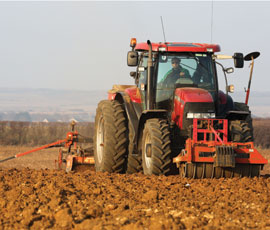New spring barley growers urged to think malt

New spring barley growers are being urged to treat their crops as if they were destined for malting and to take any premium as a bonus.
Growers are advised to get nitrogen fertiliser on as early as possible and aim for malting as there is little yield downside if the crop ends up in the feed bin.
The area of spring barley is set to soar to the highest level since the late 1980s, after many growers failed to drill all their winter crops in the wet autumn.
Most spring barley varieties are malting ones, so as long as nitrogen is applied early many crops could make malting with no yield penalty.
“Treat it as a malting crop and if you get a premium then that is a bonus,” Tim Mayhew, agronomy services manager at farming group Velcourt, tells Farmers Weekly.
His experience of growing malting barley in southern England is that all nitrogen needs to be applied by the end of the first week of April, and his crops always go for malting.
Late drilling because of the cold spring weather makes this more difficult as nitrogen will have to go on later than in Mr Mayhew’s recipe for success.
Economist Graham Redman at consultant Andersons points out that the price for new crop malting barley is currently quoted at around £175/t for November, a healthy £20-25/t premium over feed.
Even if the malting premium does narrow with bumper barley crops this season there will be no downside as there is little evidence to suggest later nitrogen helps boost yield.
“Grow for a malting premium at around 1.7% grain nitrogen, as rain seems to make more impact on yield than nitrogen,” says Mr Redman.
He calculates that by using last season’s UK average yield of spring barley of 5t/ha and a malting price of £175/t then gross margins of around £560/ha can be achieved.
Mr Redman estimates variable costs at £316/ha, split roughly equally between seed, fertiliser and sprays.
Mr Mayhew says his spring barley crops with a malting premium and fewer inputs than autumn-sown ones churn out the same gross margin as winter wheat and oilseed rape.
He looks after a sizeable area of spring barley within the 12,000ha he covers in Hampshire, Wiltshire, Dorset and Somerset, largely on light chalky soils, which are favourable for growing malting barley.
His formula is to drill in late February and early March and apply 150kg/ha of nitrogen split equally between the seed-bed and a later dressing by his target date of the end of the first week in April.
“All our spring barley goes for malting at around 1.85% nitrogen and is exported for lager making in continental Europe,” he says.
Growers do face a problem with late drilled crops this season as nitrogen should be applied early in the seed-bed and not held back.
“With late-drilled spring barley if you split the nitrogen you are guaranteed not to get malting,” he says.
He warns new growers have little chance of growing ultra high quality malt at 1.55% nitrogen, because if they are new to the crop then they are probably not on ideal spring malting barley land.
Mr Redman points out the area of malting barley is lower in continental Europe this year so there will be some export potential of the quality that Velcourt achieves.
He adds that a likely poor UK wheat crop due to the fall in autumn sowings could help support the feed barley market as there may be some substitution of feed barley for wheat in the animal feed industry.
With the weather set to warm, growers will need to watch disease and Mr Redman’s £100/ha for sprays includes a two-spray fungicide treatment.
Velcourt’s approach is to use an early T1 spray at GS30 of a triazole/strobilurin mix such as Fandango (prothioconazole+fluoxastrobin) to control rhynchosporium, brown rust and net blotch.
A second spray at T2 awn emergence (GS 49) could be a similar triazole-strobilurin mix, but if disease pressure is high, a more comprehensive and expensive triazole/SDHI mix such as Siltra (prothioconazole+bixafen) may be needed.
Phillippa Overson, product manager for Bayer, which makes Fandango and Siltra, says these two products combine well for disease control in late-drilled spring barley crops. However, she points out that for barley crops on good soils and where moisture is not limited then independent and Bayer trials have shown a yield increase from two fungicide sprays of Siltra.
UK barley exports – markets and opportunities

